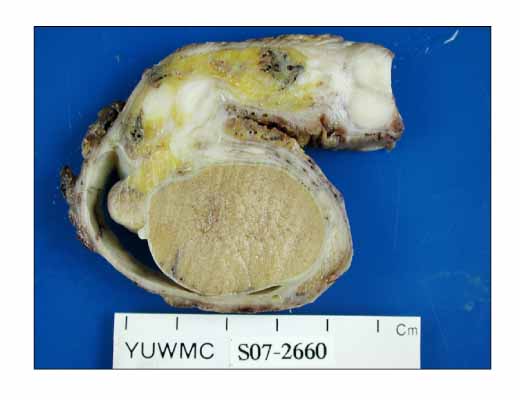Korean J Urol.
2009 Jan;50(1):92-95. 10.4111/kju.2009.50.1.92.
Local Recurrence of Spermatic Cord Leiomyosarcoma
- Affiliations
-
- 1Department of Urology, Yonsei University Wonju College of Medicine, Wonju, Korea. jjmsong@yonsei.ac.kr
- 2Department of Pathology, Yonsei University Wonju College of Medicine, Wonju, Korea.
- KMID: 2140121
- DOI: http://doi.org/10.4111/kju.2009.50.1.92
Abstract
- A leiomyosarcoma of the spermatic cord is an extremely rare tumor. A 73-year-old man complained of a soft, palpable mass in the right inguinal canal. Transinguinal radical orchiectomy was performed and histologic examination revealed leiomyosarcoma originating from the spermatic cord. Distant metastases were not observed by further examinations. At 7 months postoperatively, a local recurrence developed. Reoperative wide resection was performed and a negative margin was obtained. At 9 months reoperatively, there has been no recurrence or metastasis.
MeSH Terms
Figure
Cited by 1 articles
-
A Case of Paratesticular Leiomyosarcoma Successfully Treated with Orchiectomy and Chemotherapy
Bong Suk Ko, Nae Yu Kim, Ah Jung Ryu, Dong Soon Kim, Soo Jung Gong, Dae Kyung Kim, Hyun Jin Son, Jung-Ae Lee
Cancer Res Treat. 2012;44(3):210-214. doi: 10.4143/crt.2012.44.3.210.
Reference
-
1. Frank I, Takahashi S, Tsukamoto T, Lieber NM. Genitourinary sarcomas and carcinosarcomas in adults. Comprehensive textbook of genitourinary oncology. 2000. 2nd ed. Philadelphia: Lippincott Wiliams & Wilkins;1110–1113.2. Sogani PC, Grabstald H, Whitmore WF Jr. Spermatic cord sarcoma in adults. J Urol. 1978. 120:301–305.3. Jo EJ, Kang SJ, Han CS, Shin SJ, Choi SH. A case of leiomyosarcoma of the spermatic cord. Korean J Urol. 1989. 30:274–276.4. Ahn JS, Kim HJ, Kim YG, Park YK. A case of leiomyosarcoma of spermatic cord. Korean J Urol. 1992. 33:904–906.5. Coindre JM, Trojani M, Contesso G, David M, Rouesse J, Bui NB, et al. Reproducibility of a histopathologic grading system for adult soft tissue sarcoma. Cancer. 1986. 58:306–309.6. Dotan ZA, Tal R, Golijanin D, Snyder ME, Antonescu C, Brennan MF, et al. Adult genitourinary sarcoma: the 25-year Memorial Sloan-Kettering experience. J Urol. 2006. 176:2033–2038.7. Coleman J, Brennan MF, Alektiar K, Russo P. Adult spermatic cord sarcomas: management and results. Ann Surg Oncol. 2003. 10:669–675.8. Mondaini N, Palli D, Saieva C, Nesi G, Franchi A, Ponchietti R, et al. Clinical characteristics and overall survival in geniourinary sarcomas treated with curative intent: a multicenter study. Eur Urol. 2005. 47:468–473.9. Ballo MT, Zagars GK, Pisters PW, Feig BW, Patel SR, von Eschenbach AC. Spermatic cord sarcoma: outcome, patterns of failure and management. J Urol. 2001. 166:1306–1310.10. Watanabe J, Soma T, Kawa G, Hida S, Koisi M. Leiomyosarcoma of the spermatic cord. Int J Urol. 1999. 6:536–538.






